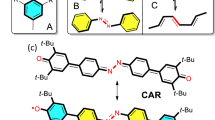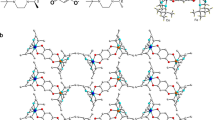Abstract
Transition-metal complexes and organic radical molecules can be used to make electric conductors and ferromagnets1,2,3, the optical properties of which can be controlled by changing temperature and are used as molecular switches and sensors4,5,6,7,8. Whereas a number of organic radicals in solution show temperature-dependent optical properties5,6,9,10,11,12, such behaviour in crystalline forms is more rare13,14,15. Here, we show a fully reversible continuous thermochromism with a unique mechanism in purely organic crystals of diazaphenalenyl radical. This behaviour is based on changes in the diazaphenalenyl dimers coexisting in the crystal. From the X-ray crystal structure analyses and temperature-dependent visible spectra, we conclude the presence of a thermal equilibrium between σ-bonded and π-bonded dimers, which are separated by 2.62(6) kcal mol−1. This conclusion is supported by room-temperature electron spin resonance spectra of the solid, which showed signals that are attributable to a thermally accessible triplet state of the π-dimer structure. This proves the coexistence of two dimers of different bonding natures in the crystal, causing it to demonstrate thermometer-like behaviour.
This is a preview of subscription content, access via your institution
Access options
Subscribe to this journal
Receive 12 print issues and online access
$259.00 per year
only $21.58 per issue
Buy this article
- Purchase on Springer Link
- Instant access to full article PDF
Prices may be subject to local taxes which are calculated during checkout




Similar content being viewed by others
References
Itoh, K. & Kinoshita, M. (eds) Molecular Magnetism 1–347 (Kodansha, and Gordon and Breach Science, Tokyo, 2000).
Miller, J. S. & Drillon, M. (eds) Magnetism: Molecules to Materials II 1–489 (Wiley-VCH, Weinheim, 2001).
Veciana, J., Rovira, C. & Amabilino, D. B. (eds) Supramolecular Engineering of Synthetic Metallic Materials 1–483 (Kluwer Academic, Dordrecht, 1999).
Balzani, V., Credi, A. & Venturi, M. Molecular Devices and Machines (Wiley, Weinheim, 2003).
Crano, J. C. & Guglielmetti, R. J. (eds) Organic Photochromic and Thermochromic Compounds Vol. 2, 415–466 (Kluwer Academic/Plenum, New York, 1999).
Maeda, K. Chromotropism—Photochromism, thermochromism, piezochromism and electrochromism. J. Synth. Org. Chem. Jpn. 44, 431–442 (1986).
Sato, Y., Tao, J. & Zhang, Y.-Z. Control of magnetic properties through external stimuli. Angew. Chem. Int. Edn 46, 2152–2187 (2007).
Nishida, S. et al. Spin transfer and solvato-/thermochromism induced by intramolecular electron transfer in a purely organic open-shell system. Angew. Chem. Int. Edn 44, 7277–7780 (2005).
Kosower, E. M. Stable pyridinyl radicals. Top Curr. Chem. 112, 117–176 (1983).
Lü, J. M., Rosokha, S. V. & Kochi, J. K. Stable (long-bonded) dimers via the quantitative self-association of different cationic, anionic, and uncharged π-radicals: Structures, energetics, and optical transitions. J. Am. Chem. Soc. 125, 12161–12171 (2003).
Small, D. et al. Intermolecular π-to-π bonding between stacked aromatic dyads. Experimental and theoretical binding energies and near-IR optical transitions for phenalenyl radical/radical versus radical/cation dimerizations. J. Am. Chem. Soc. 126, 13850–13858 (2004).
Suzuki, S. et al. Aromaticity on the pancake-bonded dimer of neutral phenalenyl radical as studied by MS and NMR spectroscopies and NICS analysis. J. Am. Chem. Soc. 128, 2530–2531 (2006).
Fujita, W. & Awaga, K. Room-temperature magnetic bistability in organic radical crystals. Science 286, 261–262 (1999).
Fujita, W., Awaga, K., Matsuzaki, H. & Okamoto, H. Room-temperature magnetic bistability in organic radical crystals: Paramagnetic–diamagnetic phase transition in 1,3,5-trithia-2,4,6-triazapentalenyl. Phys. Rev. B 65, 064434 (2002).
Itkis, M. E., Chi, X., Cordes, A. W. & Haddon, R. C. Magneto-opto-electronic bistability in a phenalenyl-based neutral radical. Science 296, 1443–1445 (2002).
Pal, S. K. et al. Resonating valence-bond ground state in a phenalenyl-based neutral radical conductor. Science 309, 281–284 (2005).
Goto, K. et al. A stable neutral hydrocarbon radical: Synthesis, crystal structure, and physical properties of 2,5,8-tri-tert-butyl-phenalenyl. J. Am. Chem. Soc. 121, 1619–1620 (1999).
Morita, Y. et al. A new trend in phenalenyl chemistry: A persistent neutral radical, 2,5,8-tri-tert-butyl-1,3-diazaphenalenyl, and the excited triplet state of the gable syn-dimer in the crystal of column motif. Angew. Chem. Int. Edn 41, 1793–1796 (2002).
Acknowledgements
This work was partly supported by PRESTO-JST, Grants-in-Aid for Scientific Research in Priority Areas ‘Application of Molecular Spins’ (Area No. 769) from the Ministry of Education, Culture, Sports, Science, and Technology, Japan, and 21COE program ‘Creation of Integrated EcoChemistry’ of Osaka University.
Author information
Authors and Affiliations
Contributions
Y.M., S.S., K.F., T.T. and K.N. planned this project, and carried out the experimental and theoretical work with the other authors. A.N., S.N., D.S. and K.S. carried out the ESR and magnetic susceptibility measurements and analyses. H.K. (Kyushu Univ.), H.K. (Univ. of Tokyo) and H.O. measured the temperature-dependent electronic spectra. A.S., Y.O., M.S. and K.S. (Rigaku Corp.) carried out the X-ray crystal structure analysis.
Corresponding authors
Supplementary information
Supplementary Information
Supplementary information - figures S1-S12 and tables S1-S11 (PDF 1751 kb)
Rights and permissions
About this article
Cite this article
Morita, Y., Suzuki, S., Fukui, K. et al. Thermochromism in an organic crystal based on the coexistence of σ- and π-dimers. Nature Mater 7, 48–51 (2008). https://doi.org/10.1038/nmat2067
Received:
Accepted:
Published:
Issue Date:
DOI: https://doi.org/10.1038/nmat2067
This article is cited by
-
Synthesis and Characterization of a Persistent Benzoanthracenyl Radical Derivative
Chemical Research in Chinese Universities (2023)
-
A Special Issue of Applied Magnetic Resonance in Honor of Professor Takeji Takui on the Occasion of his 80th Birthday
Applied Magnetic Resonance (2023)
-
Temperature-dependent luminescence of boron difluoride β-diketonates. Formation and dissociation of J-aggregates
Russian Chemical Bulletin (2023)
-
Proton-induced Conversion from Non-Aufbau to Aufbau Electronic Structure of an Organic Radical with Turn-on Fluorescence
Chemical Research in Chinese Universities (2022)
-
Recent Advances in the Synthesis of Perimidines and their Applications
Topics in Current Chemistry (2020)



